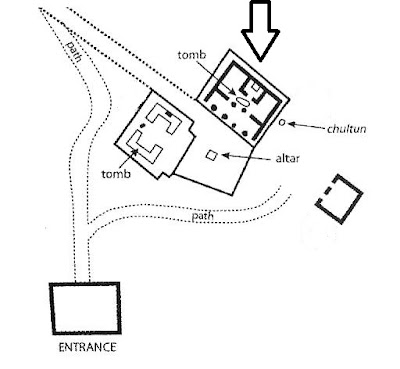Saturday, June 27, 2015
PAINTED HANDPRINTS AT THE MAYAN SITE OF SAN GERVASIO, COZUMEL, MEXICO:
Las Manitas, San Gervasio, Cozumel, Mexico.
Photograph Peter Faris, March 2015.
Las Manitas building group. Las Manitas marked by
the arrow. La Tumba to its lower left and Chichen
Nah to lower right. Hajovsky, p. 18.
On March 21, 2015, I visited the Mayan site of San Gervasio
on the island of Cozumel. There, in a structure known as Las Manitas (or the
Little Hands) are found walls decorated with red painted hand prints.
Las Manitas, San Gervasio, Cozumel, Mexico.
Photograph Peter Faris, March 2015.
Mayan settlement of the area began in the Early Classic Period (300 AD to 600 AD). (Hajovsky 2014:4) Las Manitas was constructed during the Terminal Classic (1000 - 1200 AD) and served as the residence of the halach uinik or Mayan ruler of Cozumel during that Terminal Classic Period. It has an outer room that was the residence and an inner sanctum that was a household shrine. (Wikipedia)
Hand prints from Las Manitas, San Gervasio,
Cozumel, Mexico. Photograph Peter Faris,
March 2015.
Floor plan of Las Manitas, San Gervasio,
Cozumel, Mexico. Hajovsky, p. 19.
"The structure was originally a one room dwelling, but later renovated by an elite family to include an outer room with an open, colonnaded front with plastered benches and a small inner-sanctum within the original interior room. The renovated building was purely Mayapan in style. In the 1970s, a colorful mural was still visible on the interior wall, but vandals have since chipped it away. During the 1970 excavations, a limestone sculpture of a sea-turtle was discovered in the rubble. It had probably been plastered upside-down into the ceiling, similar to others found at Mayapan. Today the turtle sculpture can be seen in the city museum. Under the floor of the interior room a tomb was also found, covered over with a huge cap-stone." (Hajovsky 2014:19)
Las Manitas is accompanied by a couple of other structures that appear to have been in relationship with it . In front of Las Manitas was a structure known as La Tumba (The Tomb). It was presented by my guide as a low pyramid, but is described in literature as an altar platform. It once supported a thatch-roofed building with a group of benches arranged around an altar. Underneath this platform was a vaulted-roofed tomb. Discovered in 1973, it is the only one of its kind discovered at San Gervasio to date. (Wikipedia)
Chichan Nah, San Gervasio, Cozumel, Mexico.
Photograph Peter Faris, March 2015.
To the east of La Manitas is found the Chichan Nah meaning small house. Also known as The Oratorio, it was constructed during the Post Classic Period (1200 - 1650 AD). This is believed to have been an oratorio, or chapel, used by the family of the halach uinik who lived in Las Manitas. It consist of a large outer room with a small inner sanctum containing an altar. (Wikipedia)
San Gervasio is believed to have been influential in the coastal ocean trade during the Mayan period. Although it does not contain the grand constructions of many mainland Mayan sites, its site on a relatively flat island covered with scrub forest means it did not have to soar over jungle canopy to look impressive to the subjects who supported it.
REFERENCES:
Hajovsky, Ric
2014 The Yellow Guide to The Mayan Ruins of San Gervasio, CZM,S. de R. L. de C. B., Cozumel, Q. Roo, Mexico
Wikipedia
Labels:
Cozumel,
Handprint,
Mayan,
Mexico,
pictograph,
rock art,
San Gervasio
Subscribe to:
Post Comments (Atom)











No comments:
Post a Comment